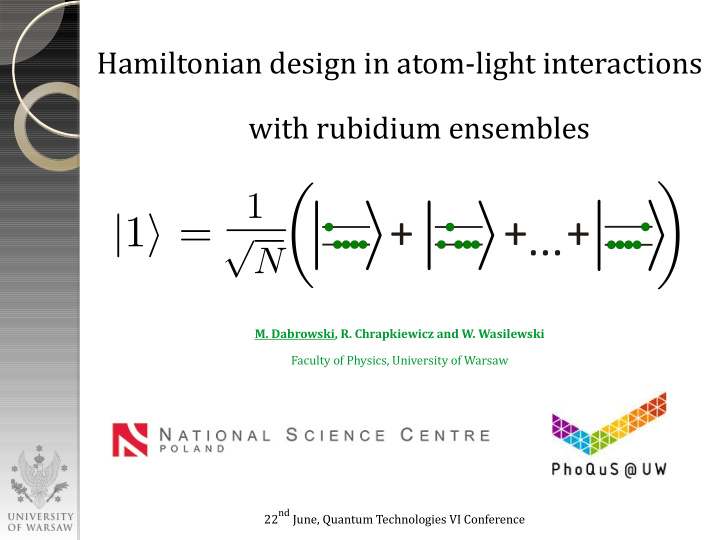



Hamiltonian design in atom-light interactions with rubidium ensembles M. Dabrowski, R. Chrapkiewicz and W. Wasilewski Faculty of Physics, University of Warsaw 22 nd June, Quantum Technologies VI Conference
Prospective applications of optical quantum memories Bussieres et al., J. Mod. Opt. (2013) single-photon heralded photons source, quantum repeaters, detector quantum sequencer quantum Internet linear quantum computer, non-linear interaction, metrology, quantum logic gates four-wave mixing magnetometry
Light-atom interface via Raman scattering Single photons assets: information storage easy to controlled manipulation inside the 87 Rb atoms weak interaction with environment Stokes scattering (spontaneous process) anti-Stokes scattering (atomic coherence needed) collective atomic excitation → spin wave effectively: two-level system, model toy of quantum optics
How the off-resonant Raman memory works? optical pumping write laser + Stokes scattered photon read laser + anti-Stokes scattered photon spin wave storage 15-6-8
Experimental demonstration Technical challenges: simplified version of experimental setup ● buffer gas and temperature ● spectral laser beams filtering ● laser frequency stabilization ● pump power fluctuations ● geometry of laser beams write region phase-matching is important! write-in storage readout read region Chrapkiewicz et al., Opt. Commun. (2014)
Spatially multimode quantum memory many spin waves inside the cell diffusion limited storage M. Parniak et al., Appl. Phys. B (2013)
Exponential growth of retrieved signal light-atom interface regulation, Hamiltonian engineering M. Dąbrowski et al., Opt. Express (2014) changing dynamics of readout, ability to amplifying signal
How it REALLY works? - our predictions coherent „classical” readout incoherent re-writing process during the memory readout four-wave mixing (FWM) process 15-6-8
Theoretical model of readout process write-in readout four-wave mixing process (during the readout) Hamiltonian in the interaction picture mean number of scattered photons
Spatially resolved correlation maps correlation coefficient four-wave mixing (FWM) Hamiltonian design via FWM „classical” pure readout
How to improve your memory? efficiency of correlated signal retrieval numerical simulation non-cloning theorem BREAKING in the experiment ?! experimental realization
Conclusion, perspectives and future plans Information storage could be realized via off-resonant Raman scattering inside the warm rubidum vapours Hamiltonian engineering is a potential tool for amplifying signal in the readout process of atomic quantum memory (Probably) we produce in our experimental setup so called two mode squeezed vacuum state → work in progress ... In the near future we plan to measure EPR-like correlations Next step would be cooling atomic memory and building MOT for better manipulation of atomic internal states and interactions
Thank you for your attention! Quantum Memories Lab Ass. Prof. Dr. W. Wasilewski R. Chrapkiewicz M. Dąbrowski M. Parniak J. Iwaszkiewicz M. Piasecki

Recommend
More recommend